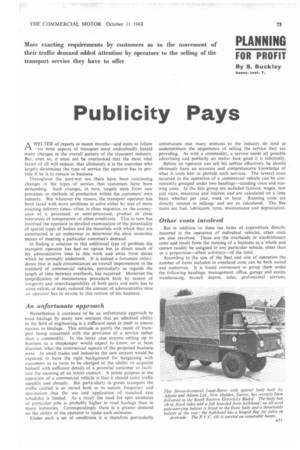PLANNING
Page 77

If you've noticed an error in this article please click here to report it so we can fix it.
FOR PROFIT
By S. Buckley
Publicity Pays
AWELTER of reports in recent months—and more to follow —on most aspects of transport must undoubtedly herald many changes in the overall pattern of the transport industry. But, even so, it must not be overlooked that the most vital factor of all will remain: that ultimately it is the customer who largely determines the type of service the operator has to provide if he is to remain in business.
Throughout the post-war era there have been continuing changes in the types of service that customers have been demanding. Such changes, in turn, largely stem from new processes or methods of production within the customers own industry. But whatever the reason, the transport operator has been faced with more problems to solve either by way of more exacting delivery times, often in close sequence, or the conveyance of a processed, or semi-processed, product to close tolerances of temperature or other conditions. This in turn has involved the operator in detailed examination of the potentiality of special types of bodies and the materials with which they are constructed in an endeavour to determine the most economic means of meeting a particular customer's demand.
In finding a solution to this additional type of problem the transport operator has had no option but to divert much of his administrative time to this work and away from duties which he normally undertook. It is indeed a fortunate coincidence that in such circumstances an overall improvement in the standard of commercial vehicles, particularly as regards the length of time between overhauls, has occurred. Moreover the simplification of maintenance procedure both by reason of longevity and interchangeability of both parts and units has to some extent, at least, reduced the amount of administrative time an operator has to devote to this section of his business.
An unfortunate approach
Nevertheless. it continues to' be an unfortunate approach to road haulage by many new entrants that an admitted ability in the field of engineering is a sufficient asset in itself to ensure success in haulage. This attitude is partly the result of transport being concerned with the provision of a service rather than a commodity. In the latter case anyone setting up in business as a shopkeeper would expect to know, or at least discover, what the commercial aspects of the proposed business were. In small trades and industries the new entrant would be expected to have the right background for bargaining with customers as to rates to be charged or the ability to acquaint himself with sufficient details of a potential customer to facilitate the securing of an initial contact. A prime purpose in the operation of a commercial vehicle is that it should carry traffic speedily and cheaply. But particularly in goods transport the traffic carried is so varied both in its nature, frequency and destination that the use and application of standard rate schedules is limited. As a result the need for spot estimates of particular jobs is probably higher in road haulage than in many industries. Correspondingly there is a greater demand on the ability of the operator to make such estimates.
Under such a set of conditions it is therefore particularly unfortunate mat many entrants to the industry do tend to underestimate the importance of selling the service they are providing. As with a commodity, a service needs all possible advertising and publicity no matter how good it is inherently.
Before an operator can sell his serVice effectively he should obviously have an accurate and comprehensive knowledge of what it costs him to provide such services. The several costs incurred in the operation of a commercial vehicle can be conveniently grouped under two headings—standing costs and running costs. In the first group are included licences, wages, rent and rates, insurance and interest and are calculated on a time basis whether per year, week or hour. Running costs are directly related to mileage and are so calculated. The five items are fuel, lubricants, tyres, maintenance and depreciation.
Other costs involved
But in addition to these ten items of expenditure directly incurred in the operation of individual vehicles, other costs are also involved. These are the overheads or establishment costs and result from the running of a business as a whole and cannot readily be assigned to any particular vehicle, other than as a proportion—albeit arbitrary—of the total According to the size of the fleet and size of operation the number of items included in overhead costs can be both varied and numerous. It is found convenient to group them under the following headings: management, office, garage and stores, warehousing, branch depots, sales, professional services,




















































































































